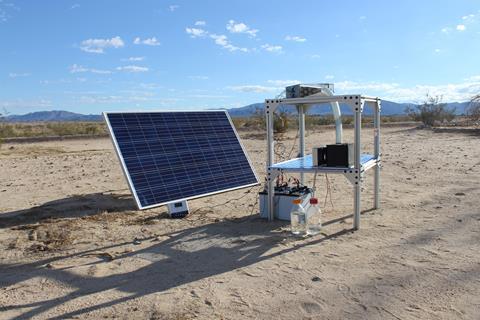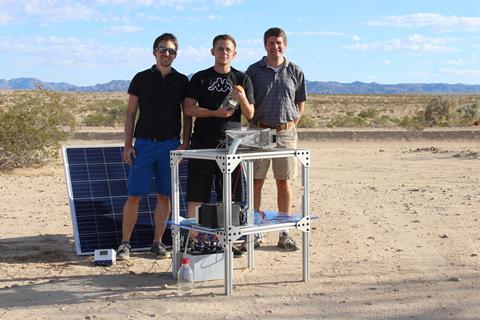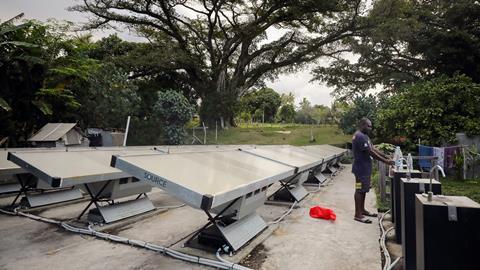With drought threatening many parts of the world, Nina Notman explores technologies for sucking water out of thin air
After three years of drought, in January 2018 the South African city of Cape Town was just 90 days away from turning off the taps. Officials warned that residents would then have to collect rationed water supplies from 200 centralised water centres. In the event, the taps stayed on. This was largely thanks to a steep drop in consumption following the announcement. Filling swimming pools and washing cars were banned. The campaign slogan ‘if it’s yellow, let it mellow’ slashed domestic usage, as did dirty shirt competitions challenging participants to wear clothes for as long as possible between washes. Imposing quotas on agricultural water usage and the return of rain to the region also helped to replenish the city’s reservoirs.
But while Cape Town closely dodged being the first major world city to run out of water, other major cities may not be so lucky – including London. The UK Environment Agency has repeatedly warned that London, and the rest of south-east England, will not have enough water by 2050 unless we change our water-wasting ways. ‘We need water wastage to be as socially unacceptable as blowing smoke in the face of a baby or throwing your plastic bags into the sea,’ James Bevan, chief executive of the Environment Agency, said at a conference in March 2019.
Scientists estimate that 4 billion people already live in regions with severe fresh water shortages for at least one month each year. This number is predicted to rise to between 4.8 billion and 5.7 billion by 2050. Reasons include climate change, polluted water supplies and increased demand due to both population growth and changes in usage behaviour.
One reason it can be hard to persuade consumers to reduce consumption is the perception that water is all around us. Over 70% of the Earth’s surface is indeed covered with water. However, only around 2.5% of that is fresh water, the rest is saline. And most of the fresh water is locked up in ice caps, glaciers and permanent snow. Less than 1% of Earth’s water is available for drinking.
There’s over six times the amount of water in vapour form around our planet than in all the rivers
Technical solutions are increasingly being sought to supply our ever thirstier world. Desalination plants, that strip salt from sea water, are undergoing a huge boon. But another lesser known family of technologies is also starting to grow in popularity: atmospheric water harvesters.
As their name suggests, these devices capture water from the atmosphere. These include technologies able to capture both gaseous water (vapour) and liquid water (droplets) from the air around us.
A cool solution
‘There’s over six times the amount of water in vapour form around our planet than in all the rivers at any given time,’ explains David Hertz, co-founder of the water harvesting company SkySource in California, US.

Technology to capture water vapour from the atmosphere has been commercially available for a couple of decades and today over 70 companies sell devices for this purpose. Situations in which atmospheric water harvesters have been deployed so far include in remote drought-struck regions, during disaster relief, where local drinking water supplies have been contaminated, by the military during operations and at remote holiday resorts with limited fresh water supplies.
Most of the commercially-available atmospheric water harvesters mimic how dew forms on vegetation in the early mornings and how condensation forms on cool items when we pull them out the fridge. When warm air comes into contact with a cool surface, it is rapidly cooled. If this is below a certain temperature, known as the dew point, the water vapour in that air condenses to the liquid phase. The resulting water droplets that form on the surface are then collected.
The market is still very small
The majority of these devices operate in the same way as mechanical dehumidifiers: a fan directs air past a cool coil upon which the water in that air condenses. They differ from mechanical dehumidifiers in two major ways though, explains Roland Wahlgren from the consulting firm Atmoswater Research in Vancouver, Canada. Firstly, robustness – water harvesters are designed to be operated 24/7, rather than to cycle on and off. Secondly, drinking water quality controls are built into the machines. ‘The coil is coated with a food grade coating so that the water that’s collected isn’t exposed to metal contamination, and the air filter is a much higher quality than in a dehumidifier,’ Wahlgren says.
Heating things up
But even though this dehumidifier-like water harvesting technology has been around for a while now, ‘the market is still very small’, explains Ruzhu Wang, a professor of refrigeration engineering at Shanghai Jiao Tong University in China. ‘The reasons are high energy consumption and initial investment costs,’ he adds. Another issue is water capture efficiency; especially in dry, desert conditions where a water harvesting technology might be most needed. The atmosphere must be humid for useful volumes of water vapour to be able to be sucked up using these tools.
These are all issues that the Water Abundance XPrize, that ran from 2016–2018, set out to address. The task was to extract a minimum of 2000L of water per day from the atmosphere, using renewable energy and for $0.02/L or less (£0.016/L, with start-up costs factored in). The winner was the Wedew (wood-to-energy deployable emergency water), developed by Skysource.
Wedew is powered by a biomass gasifier generator that turns biomass such as wood chips into electricity, biochar and hot humid air. It is the hot humid air that is fundamental for the Wedew’s water capture efficiency, creating what is effectively a rainforest-like environment inside the device. ‘We are agnostic as to ambient climate,’ Hertz explains. The warmth of the air also means ‘we can create condensation against ambient temperature surfaces’, he adds. Because the ambient surface temperature is naturally below the dew point of the hot humid air, no refrigerant or energy is therefore needed to cool the surface on which the water is collected, pulling down running costs.
To help fund the endeavour, together with the sale of the water, Wedew’s users can sell both the excess energy from the pyrolysis process and the biochar. Hertz’s says he also expects to partner with governmental agencies and NGOs to support the purchase of the Wedew by developing nations.
‘We’re currently in the early stages of commercialisation,’ he says. A few devices are currently being tested and a large programme of global case studies being planned. ‘In the next two years we would like to test different climates, different feedstocks and different cultures,’ Hertz adds.
Desiccants heading for market
Condensation against a cooler, coiled surface is the most established water vapour harvesting technology, but an alternative approach is starting to gain traction – the use of a desiccant. These hygroscopic materials suck up water like a sponge; well-known examples of desiccants include sodium polyacrylate used in baby nappies and the silica gel sachets used during transport of some electronic devices. Desiccants, such as lithium chloride solutions and silica gels, are also used in some commercially-available dehumidifiers.
Desiccants have lower energy consumption and higher water extraction efficiency
In this type of harvester, the water contents are desorbed from the ‘sponge’ by mild heating. ‘Compared with the condenser-based technology, the air water harvesting technology using desiccants has lower energy consumption and higher water extraction efficiency,’ says Wang. ‘Desiccant-based water-harvesting is [also] the only reasonable way to achieve air water harvesting in arid or desert regions,’ he adds.
The first atmospheric water harvester with desiccant reached the marketplace in 2017. The Source hydropanel, developed by Zero Mass Water, is an off-grid, stand-alone system powered by integrated solar panels. A typical dual-panel set-up produces around 10L of water per day; a volume that varies depending on humidity levels and hours of sunlight. To date, the Source hydropanel has been installed in more than 35 countries. The liquid desiccant was developed in Cody Friesen’s materials science laboratory at Arizona State University in the US. Its composition, the same as the other desiccants being commercialised for this purpose, has not been revealed.
A much larger atmospheric water harvester containing a liquid desiccant is now heading for market: the Drupps Concept, being developed by water harvesting company Drupps. Its prototype, located at the company’s headquarters in Uppsala, Sweden, produces 3000L of water per day. The set-up is modular, with additional desiccant modules able to be added for drier climates or if more water is needed, explains Drupps co-founder Fredrik Edström.
The first module of the Drupps Concept uses a fan to direct air flow past a reservoir containing the desiccant. ‘The liquid desiccant is distributed over a structure with a very high internal area,’ Edström says. The desiccant is then pumped to a second module where the water is extracted. A treatment step follows. Treatment isn’t strictly necessary as it is pure distilled water being produced – but many atmospheric water harvesters do this, to ensure potability of water that will be stored for any duration and also to add minerals for taste reasons. Demineralised water tastes ‘funky’, explains Edström.
Because the Drupps Concept is not portable and relies on an external power supply, it has a different target market to some of its competitors. According to Edström, the target is the power sector where the water produced could be used in cooling towers. ‘We’re also looking into providing a secure water source for food and beverage production,’ he adds. ‘We are in discussions regarding our first customer projects’, but the coronavirus outbreak has slowed things down.
Next-generation desiccants

Next-generation desiccants being explored for atmospheric water harvesting purposes include composite sorbents, such as the activated carbon–lithium chloride being developed by Wang, and metal–organic frameworks (MOFs). The use of MOFs for water capture started in Omar Yaghi’s chemistry laboratory at the University of California, Berkeley, US and is now being carried forward by his spin-out company Water Harvesting.1
The first water molecules aggregate to form seeds onto which other water molecules then bind
MOFs have extraordinarily large internal surface areas, meaning they can hold large amounts of water in their pores. In addition, there is a cooperative effect when they are used to capture water. ‘The first water molecules aggregate to form seeds onto which other water molecules then bind,’ explains Yaghi. ‘You start out with the water uptake low and then it increases significantly before levelling off because the pores are fully packed.’
The MOF water harvesting technology has been through a number of prototypes that have been tested in both the Arizona and Mojave deserts. ‘We can harvest water at 7–20% relative humidity – that’s the relative humidity in midday in the desert in the summer’, says Yaghi.
The first prototype was a simple plastic box-within-a-box construct. The internal box holding the MOF is opened to the air over night. ‘The water goes into the MOF and then you close the device during the day. In the desert sunshine, the inside heats up and the water comes out,’ says Yaghi. The water condenses on the inside walls of outer box, because the outside air temperature is below the dew point of the air inside the box.
This preliminary design produced 200–300ml of water per kg of MOF, depending on the atmospheric humidity levels. To boost the volume of water produced per kg of material, the team made a number of tweaks including adding solar panels. ‘A solar panel provides electricity to power small fans that push air inside the MOF and then, when the time is right, heat up the MOF to remove the water,’ Yaghi explains. ‘The energy that you need for this process is not very high because the water is not bound tightly into the pore.’

The use of solar panels and a battery means that, rather than a single day–night cycle, the MOF can be filled and empted up to ten cycles per hour, 24 hours per day. ‘We are now approaching almost an order of magnitude increase in the volume of water collected per kilo per day,’ Yaghi says.
Water Harvesting is developing devices that range in size from small kitchen countertop harvesters, producing drinking water for a household, through to large-scale devices collecting water for industrial use or to supply remote village communities. ‘We hope to unveil our next prototype when the Covid-19 situation is stabilised,’ Yaghi explains.
Thermally responsive polymers require very little energy for the water-release step
Hydrogels are another type of desiccant material being explored. These polymeric networks can absorb extremely large quantities of water. Scientists developing water harvesting hydrogels include Shanghai’s Wang and Guihua Yu at the University of Texas at Austin, US.
Yu is developing a dual-component hydrogel containing hygroscopic polypyrrole chloride penetrating a network of poly N‐isopropylacrylamide.2 The latter polymer is thermally responsive, switching from hydrophilic to hydrophobic at approximately body temperature. When the hydrogel is exposed to air, the polypyrrole chloride absorbs water vapour. Once full, the network is warmed slightly to trigger the poly N‐isopropylacrylamide to switch from hydrophilic to hydrophobic and the water droplets to therefore be released. ‘This design involving thermally responsive polymer requires very little energy for the water-release step,’ explains Yu.
In January 2019, Yu published details of the design and testing for his first prototype. The test was conducted on the roof of his university building in Austin. Mesh bags containing the hydrogel were first hung in the air for water collection. These were then placed in a sealed glass container for solar warming and, therefore, water release. ‘We found that one cycle takes about 45 minutes absorption followed by 5–10 minutes for water release,’ Yu says. Over the 10 day test, the team ran around 20 cycles per day finding that the amount of water collected varies significantly with humidity levels during the day. ‘We obtained about 25–30L of water per kilogram of gels per day,’ he explains.
Yu says he is currently focused on bringing down the cost of the hydrogel and finding a suitable partner for ‘a more commercial demonstration’ of the technology.
Bio-inspired fog harvesting coatings
Both condensation- and desiccant-based atmospheric water harvesters collect water vapour. There is a third technology of this type that instead collects liquid water droplets already present in the air –fog harvesters.
Huge fabric meshes for fog water collection have been in operation for decades in locations of the world that experience both water scarcity and frequent fog, such as the Atacama and Namib deserts. Fog forms particularly well by the coast and up mountains. There is a current R&D focus on developing novel meshes and coatings to boost water capture efficiency. Traditional meshes only collect about 3L of water per day per square metre of fabric.
Many of these new designs are inspired by nature. Liqiu Wang at the University of Hong Kong, for example, has been trying out nets that mimic spider webs. And Tak-Sing Wong at Pennsylvania State University in the US has been copying the design of pitcher plants and rice leaves. Cactus‐like structures and those that mimic the shell of the Namib desert beetle are also under development elsewhere.
Wang uses microfluidic technology to mimic the structure and microscale surface roughness of spider webs. A mixture of polymers and sodium alginate in water is ‘passed through a flow process’ to produce a very thin layer of liquid, he explains. This thin layer of liquid has nitrogen bubbles injected into it at very tightly defined locations. The liquid is then solidified by putting in hygroscopic calcium chloride. When solidified, the gas bubbles in the fibre form structures that Wang has termed knots, and it is these that give the desired structure and surface roughness.
Surface chemistry can capture the water droplets from air very efficiently
In 2017, his team reported the laboratory test of his knotty microfibres finding that the water capture efficiency is ‘two to seven times’ that of traditional fog harvesting meshes (depending on the environmental conditions). ‘Since then we have continued improving the fibre performance,’ explains Wang. ‘We have not reached the stage where we can commercialise our technology yet but we are still planning to do that.’
The mesh coating being developed in Wong’s lab in the US is focused on improving the ease with which captured water droplets slip off the mesh for collection. ‘Water droplets get stuck to the material in current fog harvesters,’ he explains. ‘The surface chemistry can capture the water droplets from air very efficiently and, once absorbed, they can be removed rapidly because we create a slippery coating on to the material.’ In a 2018 paper, the team reported ‘dramatic’ improvements over conventional liquid-repellent surfaces used for this application.
Wong’s coating has two polymeric layers. A lower one with micro- and nanoscale roughness that mimics the hydrophobic surface of the rice leaf. And a semi-permanent upper lubricant layer that resembles the slippery surface of the pitcher plant leaf – it’s this property that enables the U-shaped leaf to ensnare insect prey so efficiently. ‘We have a US patent so that we’re in the process of looking for the right commercial partner to translate this technology to the commercial space,’ explains Wong.
Atmospheric water harvesters will never be the single answer to our growing water crisis. But all three types of devices discussed here – condensation against cool coils, desiccant-based and fog harvesters – have the potential to play an important part in the multi-pronged approach needed to keep the world’s taps on. As the world heats up, it is reassuring to see the world’s scientists getting all these technologies oven ready.
Nina Notman is a science writer in Salisbury, UK
References
1 N Hanikel, M S Prévot and O M Yaghi, Nat. Nanotechnol., 2020, 15, 348 (DOI: 10.1038/s41565-020-0673-x)
2 F Zhao et al, Adv. Mater., 2019, 31, 1806446 (DOI: 10.1002/adma.201806446)













1 Reader's comment